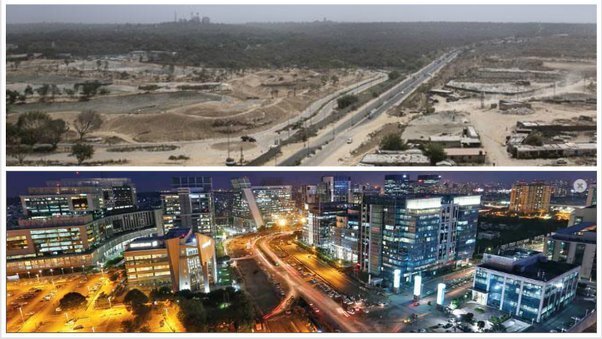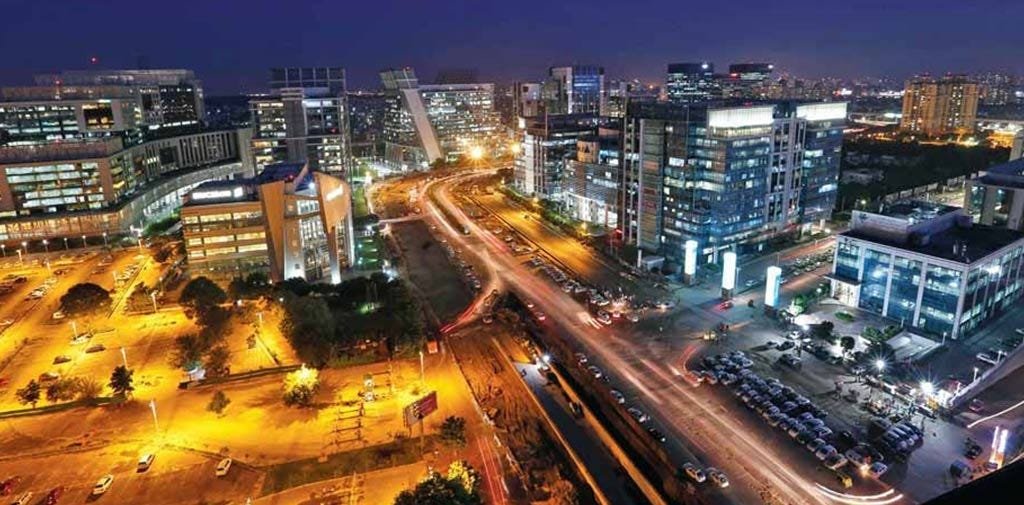Success Story of Gurgaon: Gurgaon’s Remarkable Transformation: Balancing Growth and Challenges
In just two short decades, Gurgaon has undergone a remarkable transformation from a quiet farming village to. A bustling urban center that rivals some of the world’s most dynamic cities. Located approximately 15 miles south of the Indian capital, New Delhi, Gurgaon’s rapid development has turned. It into a symbol of India’s emerging “new” economy. However, beneath the glitz and glamour, Gurgaon also presents a complex set of challenges and opportunities. Highlighting the need for careful planning and infrastructure development in India’s rapid growth.
From Village to Megacity: The Early Years
Gurgaon, with its origins steeped in agriculture, was once a farming village. Its name, derived from the Hindu epic, the Mahabharata, means “village of the gurus.” The landscape was dotted with blue cows, known for their strangely bluish tint, and the area was far removed from the urban sprawl of New Delhi.

In 1979, the state of Haryana took a significant step in dividing a longstanding political district on the outskirts of New Delhi. One half would revolve around NCR (National Capital Region), which boasted an active municipal government, direct rail access to the capital, fertile farmland, and a robust industrial base. The other half, Gurgaon, had rocky soil, no local government, no railway link, and almost no industrial base.
Despite these initial challenges, growth in Gurgaon was slow but steady until 1991 when India embarked on market economic reforms. This period marked a turning point for Gurgaon and the entire nation. As the government introduced economic reforms and liberalization, demand for housing and commercial space began to surge. Multinational corporations recognized India’s potential, and many chose Gurgaon as their base to tap into the country’s emerging outsourcing industry.
The Building Frenzy: Gurgaon’s Skyrocketing Development
The rapid influx of multinational corporations and the need for workspace for thousands of white-collar employees led to a frenzied construction boom in Gurgaon. The city’s skyline started to change dramatically. Today, Gurgaon boasts an astonishing 30 million square feet of commercial space, a tenfold increase from 2001, even surpassing the total in New Delhi itself.
Ordinarily, such a wild building boom would have needed to adhere to a local government master plan. However, Gurgaon was yet to have such a plan in place, and it also lacked a district-wide municipal government. Instead, the city was mostly under state control, and developers took over. The responsibility of constructing infrastructure within their projects. A state agency, the Haryana Urban Development Authority (HUDA), was tasked with building. The essential infrastructure that would bind the city together.
Challenges and Opportunities: The Gurgaon Conundrum
While Gurgaon has emerged as a shining example of India’s economic prowess, it has not been without its challenges. Initially marketed as Millennium City, it has experienced difficulties in managing its rapid growth. For companies that came to India in search of business efficiencies, Gurgaon presented new challenges that they had to overcome on their own.
Despite the inefficiencies, outsourcing has thrived in Gurgaon. In the last year alone, a leading Indian industrial association estimated that outsourcing was directly. And indirectly responsible for approximately 500,000 jobs in Gurgaon. Companies continue to gravitate toward Gurgaon because of its modern and abundant commercial spaces, which are far more cost-effective than those in New Delhi. Additionally, Gurgaon acts as a magnet for India’s best-educated, English-speaking young professionals—the essential raw material in the outsourcing business. The city is home to a concentration of expertise, with corporations like Coca-Cola, PepsiCo, Motorola, Ericsson, and Nestle India setting up offices in Gurgaon over the past decade
Gurgaon as a Model and Cautionary Tale
Across India, Gurgaon serves as both a model and a cautionary tale. Other cities aspire to emulate its growth and dynamism but seek to avoid the dysfunction and lack of planning. Meanwhile, Gurgaon itself is striving to address its infrastructure woes. Recently, the city was connected to the New Delhi rapid transit system, and a public-private project is underway to construct a link to Cyber City. However, the state and local governments are still struggling to keep up with the pace of development, especially since Gurgaon is already planning to create more industrial and commercial space.
Conclusion: Gurgaon’s Journey and India’s Urbanization Challenge
In conclusion, Gurgaon’s journey from a humble farming village to a global outsourcing hub is a testament to India’s rapid development. However, it also underscores the importance of balanced growth and meticulous planning. And robust infrastructure development to ensure sustainable urbanization in the face of relentless expansion. Gurgaon exemplifies both the promise and the pitfalls of India’s transformation into a global economic powerhouse. It serves as a valuable case study for cities around. The world grappling with similar challenges in the era of rapid urbanization. As India continues to grow and evolve. Striking the right balance between progress and sustainability remains an ongoing endeavor.





Join The Discussion